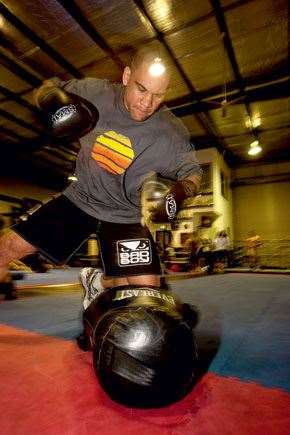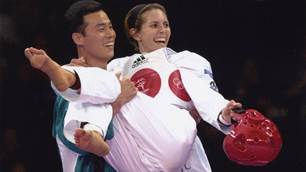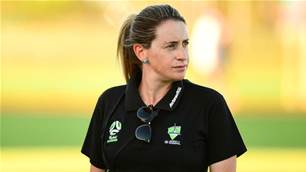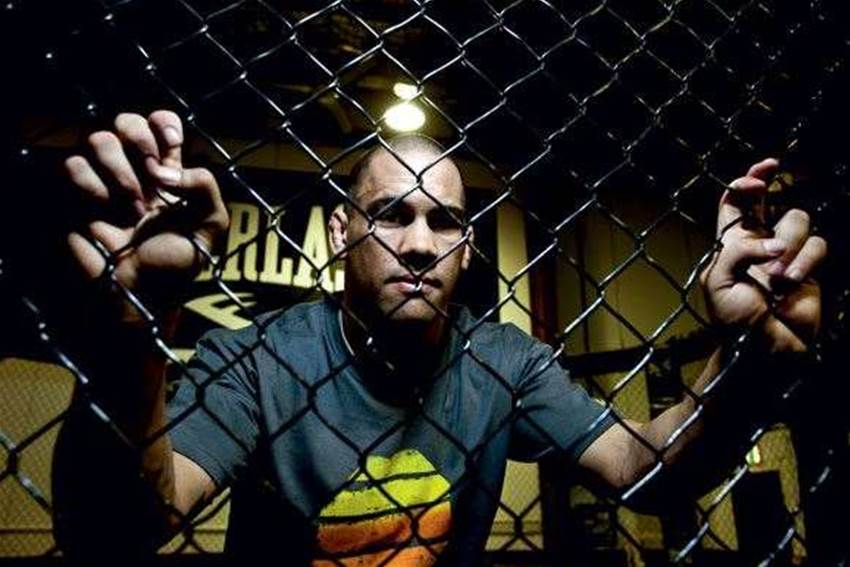His 19 professional Mixed Martial Arts (MMA) fights have yielded 14 victories, seven of them by fistic knockout.
The punch
“Amateur-style boxing tends to suit MMA. Everything has to be from a distance – you can’t get too close throwing punches because you can get hurt off the jab or you can get taken to the ground. So you’ve got to keep your distance, got to stay long. It’s all about being evasive, elusive. I’m lucky enough to be trained by Lincoln Hudson, who also trains the Olympic boxer Brad Pitt. So my training’s similar to regular boxing training – bags, pads, sparring. Unfortunately, I just don’t have enough hours in the day to train like a pro boxer because of all the other disciplines I have to cover. I might only get two days of boxing in a week. I do a lot of focus pad work, a lot of soft sparring, a little bit of hard sparring and heaps
of footwork. The focus is always on staying elusive, not being heavy-footed. And, of course, whenever I’m doing boxing training, I’m always thinking about transitioning to the takedown, and defending myself against the takedown.”
 James Te Huna Punch Practice
James Te Huna Punch PracticeImages: Warren Clarke
The kick
“Not many kicks are used in the MMA. There used to be more in the past, but now most fighters use an opponent’s kick as an opportunity to take him down because he’s off-balance, he’s up on one leg. So kicking can be dangerous – but it can also be useful, particularly late in the round. Kicks can also be very dangerous against an opponent who doesn’t defend well, who’s very heavy-footed. So you always want to keep some good, fast kicks in your arsenal. My strongest kick is the left inside-leg kick. With that kick, from an orthodox stance, I’m kicking outwards, so I can keep my distance. Whereas to land a right-leg kick, I have to step in and kick inwards, so all my weight’s coming forward. That can open me up to a takedown.”
On the ground
“There’s huge number of jujitsu techniques that we don’t practise because they’re too risky with punches involved. You can get stuck in a ground-and-pound – you can get hurt. So there are just a few techniques that work in MMA, and they’re the ones we focus on. The basic rules are: if you’re on your back, keep your opponent close to you, or get him out of the punching range so he can’t hurt you. If you’re on top, then you want to create a gap so you can land punches, or pull him in tight for a submission. So it’s tricky – it goes both ways! My wrestling’s not too bad – I can survive. Except in my last fight... “(At UFC 127, Te Huna suffered an opening round submission defeat to Swede Alexander Gustafsson.)
Conditioning
“Because MMA rounds last five minutes, conditioning’s a big factor in the sport. It’s all about working your whole body, staying fast, using your speed, and maintaining explosive power. It’s very, very hard – it always breaks me down! But it’s just something you’ve got to do. Of course, sparring’s the number-one way of building your conditioning. You can’t beat sparring. But personally, I like to mix my conditioning work up. So I might do circuit exercises, where I’ll do, say, ten power cleans, then 20 push-ups, then 50 double-jumps, then a 100m sprint. Then I’ll repeat that circuit, non-stop, until five minutes is up. I also do interval sessions where I’ll go 30 seconds on, 30 seconds off, with an active rest. So I’ll do, say
30 seconds of hitting the heavy tyre with a hammer, then I’ll do 30 seconds of shadow-boxing, then I’ll do 30 seconds of flipping the tyre, then 30 seconds of skipping. Again, I’ll do that non-stop for five minutes. I find that’s really good for replicating a fight, where you exchange punches – boom-boom-boom – then you step away and circle for a while.”
Mind games
“The key with your mind is just to focus on your fight and keep a clear head. If any problems come your way – you’ve got toeither resolve them or brush them off. Family problems, recurring injuries – these things can get in your head and bring you down. They can turn a positive attitude into a negative one just like that. With my last fight at UFC 127, my father had a heart attack four weeks out. I’m really close with my dad, so I was going to the gym but thinking about him, instead of going home and resting, I was going to the hospital. Things like that can bring you down. So you’ve just got to stay positive, man. Any negative thoughts you’ve just got to leave them behind. Being in a positive environment, having a positive group of people around you – that’s the key. You know, I’ve trained with so many guys who are absolute animals in the gym, punish everyone. But then they have a fight and they crumble. They can’t deal with it. They don’t believe they’re at the right level. They break down in the middle of the fight. And that’s the worst thing that can happen to a fighter. You have to stay positive.”
The F word
“Fear used to figure in my mind before fights. I used to look at the other guy and go, ‘Oh man! He’s got a big set of muscles on him! He’s taller than me! I don’t want to fall on my face – my family’s coming here to watch me…’ I put pressure on myself. But I got over that after a few fights. I learnt how to deal with it. You just can’t worry about the other guy. If he’s got good hands on him, you think, yeah, but I’ve got a good take-down. If he’s got a long reach you think, yeah, but I’m good at getting inside. Things like that. You’ve just got to believe in yourself. There are some fights where I’ve really built up a hatred for the other guy, and I want to put him away as fast and as hard as I possibly can. Sometimes that works. But other times I’ve met my opponent previously – we’ve talked, we know each other’s game, we’re friends. So I’ve come out smiling before the fight.”
Related Articles

Garriock ready to put the boot into new role

Sydney Olympic hero reminisces about her golden moment













